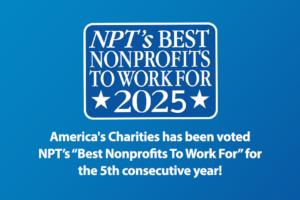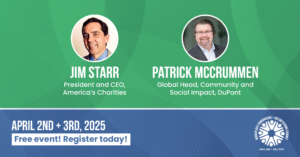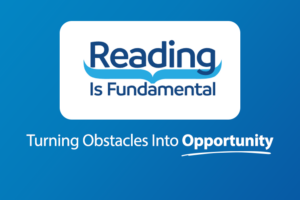Sarah Ford | June 23, 2014
Snapshot 2014: How Are Nonprofits Responding to Rising Expectations of Corporate and Individual Donors?
By Lynne D. Filderman and Steve Greenhalgh
(This post was originally featured in CSRwire’s CSRwire Talkback blog series.)

Having just released the latest research on employee engagement and corporate–nonprofit partnerships, we’ve been reflecting on how corporate giving and workplace giving, both time honored traditions, are changing.
Both of us have spent our careers working across the corporate and nonprofit sectors with a particular focus on building successful partnerships and advocating for strong employee engagement programs. We have witnessed first-hand the evolution from check writing philanthropy to a more strategic focus and one that is responsive to the company’s mission and employee charitable interests.
The Evolution of Workplace Giving
Yes, workplace giving has evolved from having a single choice to offering an expanded list of charities and causes to offering full year-round employee engagement. In fact, through the years workplace giving has grown to more than $4 billion annually.
In February 2013, America’s Charities released Snapshot 2013: Trends and Strategies to Engage Employees in Greater Giving, revealing a dramatic shift in employee giving over the past decade.
We followed that up with several engagement opportunities with other charities to determine how they were changing structures and operations to adapt to a quickly transforming culture.
This dialogue led to the release of a companion piece titled Snapshot 2014: Rising Tide of Expectations – Corporate Giving, Employee Engagement and Impact a few weeks ago at the National Press Club in Washington D.C.
Accountability: What the Nonprofits Have to Say
As the primary authors of this report, we feel the research contributes greatly to the discussion around impact and accountability and hope that it will drive companies and charities to look deeper into how they can invest in making a difference in communities in the U.S. and around the world.
To our knowledge, this is the first time charities have been asked to provide their perspective on workplace giving and corporate partnerships. Yet, charities are a key but often silent, stakeholder in giving at the workplace.
And while the findings from Snapshot 2014 are intriguing, we are fascinated with the new world charities are facing with employee engagement, the digital culture and donor expectations. More importantly, it is encouraging to see that charities are responding.
Going Beyond Communicating Mission & Reporting Outcomes

With brand and name recognition no longer enough to warrant support, there is a universal expectation that charities will be more transparent and forthcoming in describing impact and outcomes of their programs and services. Correspondingly, charities understand these higher expectations and are changing the way they operate.
For instance, they are making more information readily available [see chart on right] with more than 94 percent using digital media. As the use of social media platforms increases, charities are able to tell their story directly to potential donors –90 percent of responding charities said they use social media to deliver messages and communicate with stakeholders.
Measurement and impact are important parts of the dialogue emerging out of Snapshot 2014. We found that charities, almost universally, buy into the concept of being accountable and transparent as outlined in the Overhead Myth campaign.
From Concept to Delivery
However, Snapshot 2014 did find a discrepancy between their understanding of transparency and accountability and how to demonstrate the specific components of each.
As the chart shows, 82 percent of responding charities agree that accountability and transparency are important elements of good governance but only a small percentage feels the key components that demonstrate good governance are as important as the general concept.
This is worrisome and to meet these greater expectations, charities must go beyond communicating their mission or reporting on outcomes. One of the key takeaways is the need to educate nonprofits on what it means to be transparent and have good governance as well as how to communicate and demonstrate these traits.
But Snapshot 2014 also found universal recognition of the rise of charity validators as third party sources of information including BBB Wise Giving Alliance, Charity Navigator, GuideStar and GreatNonprofits. Charities recognize that donors are turning to these validators for information and for an independent assessment of charities’ effectiveness. Charities are not only looking to work with these groups, they also see them as valuable partners in validating their work.
Employees Are Interested in More Year-round Giving Opportunities
On the other hand, companies report that employees are requesting more year-round involvement engagement with charities. No longer is a once-a-year fund raising campaign adequate to meet the social and charitable needs of employees.
At the same time, charities report seeing a significant increase in the number of corporate requests to engage with their employees. Charities understand that honoring these requests is important and the new culture of hands-on experiences is valuable in building connections with corporations and individual donors.
However, as the number of requests for volunteer events increases, companies will need to recognize that not all charities are equipped to handle requests for volunteerism in a meaningful way. While charities clearly value their corporate relationships, they are challenged to sustain them as the nature of engagement and volunteerism evolves. (see chart).
The Need for Dialogue
The most actionable finding of the survey perhaps is the need for healthy dialogue between corporations and nonprofits to determine how best to partner and meet the desires of employees and the needs of the charity. When was the last time a company and a nonprofit discussed one another’s strategic goals as a way to leverage their partnership?
But we are hopeful that as the tide shifts from singular and often insular acts of charity to more strategic year-round engagement, the dialogue between corporations and their charity partners will take a deeper dive to build a partnership that is valued, has impact and is mutually beneficial. The conversations have begun – now we need to scale.
Get Resources and Insights Straight To Your Inbox
Explore More Articles
For Fifth Consecutive Year America’s Charities Named ‘Best Nonprofit To Work For’
Washington, D.C. – April 1, 2025 – America’s Charities, the nonprofit that mobilizes the power of giving as a leading provider of volunteering, workplace giving,…
Read ArticleWorkplace Fundraising + Volunteering Summit (April 2nd and 3rd, 2025)
Join us in attending this virtual summit! The America’s Charities team is joining up with other leading voices in the workplace giving space for a…
Read ArticleThe Time to Act is Now
The results of the 2024 National Assessment of Educational Progress (NAEP) are in, and the findings are, in a word, heartbreaking. This assessment serves as…
Read ArticleGet Resources and Insights Straight To Your Inbox
Receive our monthly/bi-monthly newsletter filled with information about causes, nonprofit impact, and topics important for corporate social responsibility and employee engagement professionals, including disaster response, workplace giving, matching gifts, employee assistance funds, volunteering, scholarship award program management, grantmaking, and other philanthropic initiatives.






